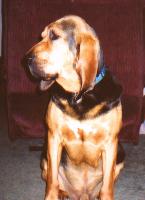What You Should
Know about the
Bloodhound Dog
|
|
Please Help Homeless Pets by Donating One Dollar
A Prescription for the Care of your Bloodhound
Tippy & Alfred
Bloodhounds are very large dogs, and consequently are prone
to bloating and gas. They should be fed two to three small
meals a day instead of one large one to avoid this. Also do
not exercise the dog directly after it has eaten. They can
suffer from stomach cramps.
They also often suffer from hip dysplasia as they get older.
Some have a problem with ear infections. In order to avoid
calluses on the joints, a padded dog bed is best for them to
sleep on. Some Bloodhounds have a problem with the eyelids
turning inward and irritating the eyeball and need surgical
correction for the problem.
The male dog can reach twenty-five to twenty-seven inches
in height and weigh between ninety and one hundred and ten
pounds on average. The female dog can reach twenty-three
to twenty-five inches in height and weigh between eighty
and one hundred pounds on average. This is based on
healthy averages for this dog breed.
A Bloodhound will be okay living in an apartment if it gets
enough exercise. They are lazy when indoors but when
outdoors are energetic and happy. They do better when living
in a home with a fenced average-size yard.
The Bloodhound needs a lot of exercise and love a good long
run. They need a daily long walk to take care of physical
and psychological needs. But be careful to always have a
good grip on their leash in case they take interest in a
scent. Never let this dog off the leash outdoors.
Bloodhounds have incredible stamina levels and can walk for
days, literally. If they do manage to get away from you they
will likely ignore you and go after the scent that caught
their attention, it is instinctive.
They really like hiking with people in the woods where there
are all kinds of scents to smell. Be careful to not overtire
a young bloodhound. A young Bloodhound that is still growing
needs all of their energy for bone and muscle growth and
development.
The Bloodhound lives on average ten to twelve years. They
have an average liter size of between eight and ten puppies
but some litters have been reported to contain up to fifteen
puppies. Be careful not to let this dog be injured when it
is young, any damage to the joints is usually irreversible
and will bring on joint problems all the sooner.
Picture of Bloodhound

Needs for Bloodhounds
Jane R. Bicks, D.V.M
Who can't love those big eyes, long ears, and
loving personality of the Bloodhound?
The best way to keep their skin, ears, and joints
healthy is to feed a high quality alternative professional
food in a dish elevated to shoulder height, and
to keep the 2 or 3 meals on the skimpy side rather
than overfeeding.
Since bloat is a real problem in the Bloodhounds,,
a vegetable enzyme should be added to the food
to ensure increased digestion.
See our page on How to Prevent Bloat in Bloodhounds
http://petcaretips.net/bloat-dog.html
Washing the ears with equal parts vinegar and
water 3-4 times a week is imperative to keep them
clean. The average lifespan of the Bloodhound is
under 10 years, so antioxidants after the age of
2 are essential!
Here's the Best in Dog Food and Treats for
your Bloodhound Dog
Online
Here
Everything you wanted to know about Dog Breeds
|